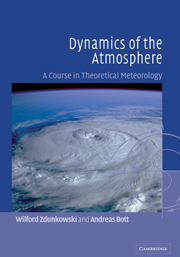Book contents
- Frontmatter
- Contents
- Preface
- Part 1 Mathematical tools
- Part 2 Dynamics of the atmosphere
- 1 The laws of atmospheric motion
- 2 Scale analysis
- 3 The material and the local description of flow
- 4 Atmospheric flow fields
- 5 The Navier–Stokes stress tensor
- 6 The Helmholtz theorem
- 7 Kinematics of two-dimensional flow
- 8 Natural coordinates
- 9 Boundary surfaces and boundary conditions
- 10 Circulation and vorticity theorems
- 11 Turbulent systems
- 12 An excursion into spectral turbulence theory
- 13 The atmospheric boundary layer
- 14 Wave motion in the atmosphere
- 15 The barotropic model
- 16 Rossby waves
- 17 Inertial and dynamic stability
- 18 The equation of motion in general coordinate systems
- 19 The geographical coordinate system
- 20 The stereographic coordinate system
- 21 Orography-following coordinate systems
- 22 The stereographic system with a generalized vertical coordinate
- 23 A quasi-geostrophic baroclinic model
- 24 A two-level prognostic model, baroclinic instability
- 25 An excursion concerning numerical procedures
- 26 Modeling of atmospheric flow by spectral techniques
- 27 Predictability
- Answers to Problems
- List of frequently used symbols
- References and bibliography
- Index
15 - The barotropic model
Published online by Cambridge University Press: 05 June 2012
- Frontmatter
- Contents
- Preface
- Part 1 Mathematical tools
- Part 2 Dynamics of the atmosphere
- 1 The laws of atmospheric motion
- 2 Scale analysis
- 3 The material and the local description of flow
- 4 Atmospheric flow fields
- 5 The Navier–Stokes stress tensor
- 6 The Helmholtz theorem
- 7 Kinematics of two-dimensional flow
- 8 Natural coordinates
- 9 Boundary surfaces and boundary conditions
- 10 Circulation and vorticity theorems
- 11 Turbulent systems
- 12 An excursion into spectral turbulence theory
- 13 The atmospheric boundary layer
- 14 Wave motion in the atmosphere
- 15 The barotropic model
- 16 Rossby waves
- 17 Inertial and dynamic stability
- 18 The equation of motion in general coordinate systems
- 19 The geographical coordinate system
- 20 The stereographic coordinate system
- 21 Orography-following coordinate systems
- 22 The stereographic system with a generalized vertical coordinate
- 23 A quasi-geostrophic baroclinic model
- 24 A two-level prognostic model, baroclinic instability
- 25 An excursion concerning numerical procedures
- 26 Modeling of atmospheric flow by spectral techniques
- 27 Predictability
- Answers to Problems
- List of frequently used symbols
- References and bibliography
- Index
Summary
Barotropic and baroclinic atmospheric processes manifest themselves in the numerous facets of large-scale weather phenomena. Typical examples are the formation and propagation of synoptic waves having wavelengths of several thousand kilometers and the characteristic life cycles of high- and low-pressure systems. The barotropic and baroclinic physics provides the physical basis of numerical weather prediction. In this chapter we will consider various aspects of barotropic models. It is realized that the prediction of the daily weather by means of barotropic models is no longer practiced by the national weather services. Nevertheless, by discussing the mathematical theory of the barotropic physics we can learn very well how physical variables are interconnected and how much care must be taken to construct even a very simple prediction model. The first numerical barotropic weather-prediction model was introduced by the renowned meteorologist C. G. Rossby and by the famous mathematician John von Neumann. Baroclinic models will be described in some detail in later chapters.
Barotropic models are short-range-prediction models that include only the reversible part of atmospheric physics. The consequence is that the atmosphere is treated as a one-component gas consisting of dry air. The irreversible physics such as non-adiabatic heating and cloud formation is not taken into account.
The basic assumptions of the barotropic model
The name of the model is derived from the assumption that the atmosphere is in a barotropic state throughout the prediction period. The condition of barotropy by itself, however, is not sufficient to construct a barotropic prediction model; additional assumptions are mandatory. The model described here rests on three basic assumptions.
- Type
- Chapter
- Information
- Dynamics of the AtmosphereA Course in Theoretical Meteorology, pp. 435 - 470Publisher: Cambridge University PressPrint publication year: 2003



